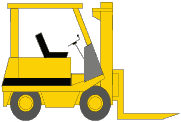"INDRUSTRAIL AND LEAD-ACID BATTERIES."
- INDRUSTRAIL BATTERIES.
- LEAD-ACID BATTERIES.
A Few Words About Industrial
Batteries"Battery Life
The modern industrial lead-acid battery is ruggedly built and with reasonable care
will give many years of service. Normal battery life is 5 to 7 years or 1500 to 2100 charge/discharge cycles. Your
industrial battery represents a sizable investment that will not be fully recovered if its useful life is drastically
shortened. This can happen through neglect or poor operating practices. Three of the batteries worst enemies are
: Overcharging/undercharging, Low electrolyte level, and Deep discharge cycles.
Overcharging and/or poor maintenance can be causes of low electrolyte level. Excessively low electrolyte level
causes a portion of the plates to become exposed. The result is overheating and damage to the active material on
the positive plates. Consistent undercharging can cause residual sulfation because not all of the active material
is being returned to the positive plates on each charge. Although theses conditions can lead to premature failure,
deep discharge is potentially the most damaging. The result is decreased ampere-hour capacity, shortened life (fewer
charge/discharge cycles), increased internal resistance (decreased efficiency) and increased chance of shorted
cells.
Deep Discharge
Deep discharge for most batteries means going below 1.140 specific gravity or 1.70
volts/cell, and is caused by continuing to draw energy from a battery that has reached its discharge limit. During
deep discharge, too much of the active material (lead peroxide) leaves the positive plates and not all of it returns
during charging. This reduces the effective plate area. Over time, the lost active material stays in the electrolyte
or ends up in the bottom of the cell jars as lead sulfate. It is now "out of action" and does not contribute
to the batteries ability to store energy. It piles up and may contact the plates causing a shorted cell and loss
of energy. A severely sulfated battery must be replaced because it: will not hold a charge, will not last a full
8 hour shift, costs more to charge, uses excessive water and has increasing repair costs.
Proper Battery Care
Proper selection and care of your battery will help ensure that it will have a long
and productive life. Make sure that the battery is adequately sized for the application. An undersized battery
will overheat from high current draw and may not last through a full 8 hour shift.
Over time, cells can become unequally charged. An occasional equalizing charge will help correct cell-to-cell imbalances.
Starting charge rates should not exceed 25 amps per 100 A.H. of capacity. Finish rates should be about 5 amps per
100 A.H. of capacity. Make sure that the cell voltage stabilizes at 2.37 volts/cell during the last 2 hours of
finish rate charging. Check the electrolyte level, cell voltages and S.G. frequently. Keep a record of the maintenance
performed on each battery.
Above all, avoid discharge below 1.140 specific gravity! If in doubt, check the battery manufacturer's recommendations
for proper charging rates and discharge limits for your battery. One of the best ways to prevent over discharging
is to add a battery gauge and/or lift interrupt circuit. Next time we will look at several common battery protection
devices, how they work and how the interupt lift circuits help ensure proper vehicle battery maintenance.
[-TOP-]
LEAD-ACID BATTERY
Our discussions thus far have been related to controlling our Electric Forklift so
that the driver can perform his/her duties smoothly. We must not forget the one device that enables us to operate
the forklift without fuel or cords tying us down.
The largest player in our electric game is the Lead - Acid Battery. The battery is a DC source consisting typically
of two or more cells which converts chemical energy into electrical energy.
The theory of operation of our forklift battery is the same as our automotive battery. Our automotive battery obviously
operates on a slightly smaller scale. Like the batteries used in our personal vehicles they are made up of individual
cells connected in series. The number of cells used depends on the voltage required. Our automotive batteries are
rated at twelve volts and I'm sure that most of you have noticed that you have 6 individual filling ports for adding
water. Each individual filling port represents one battery cell.
The cells in any lead - acid battery is equal to approximately 2.0 to 2.2 volts per cell. That means that your
typical car battery may charge as high as 13.2 volts (2.2 volts/cell multiplied by the number of cells, in this
case 6 cells).
The forklift battery measures the same way. As an example a 36 volt forklift battery is made up of 18 individual
cells, which means a fully charged 36 volt battery may reach as high as 39.6 volts (18 cells multiplied by 2.2
volts/cell). Some mechanics actually refer to a battery as a representation of the number of cells, a 36 volt battery
may be referred to as an 18 cell battery.
A lead - acid battery is filled with a solution of sulfuric acid and water called the electrolyte.
Electrolyte by definition is a substance or solution in which the conduction of electricity is accompanied by a
chemical action. The chemical action produced by discharging a battery actually turns our electrolyte solution
more and more into water.
Since this chemical action is reversible by recharging the battery and chemically changing our electrolyte back
to its original formulation our lead - acid battery is called a secondary battery, as opposed to a primary battery
which is not rechargeable.
[-TOP-]
 BE SURE TO VISIT THE HOME PAGE FOR INFORMATION ON LIFT TRUCKS REPAIR, SERVICE,
TROUBLESHOOTING, AND EVERYTHING YOU NEED TO KNOW ABOUT FORKLIFTS AND THEIR USE.
BE SURE TO VISIT THE HOME PAGE FOR INFORMATION ON LIFT TRUCKS REPAIR, SERVICE,
TROUBLESHOOTING, AND EVERYTHING YOU NEED TO KNOW ABOUT FORKLIFTS AND THEIR USE.
 --BACK TO
HOME PAGE. --BACK TO
HOME PAGE.
|

